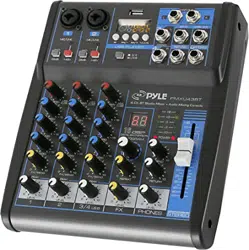Loading ...
Loading ...
Loading ...

www.PyleUSA.com www.PyleUSA.com
5 6
Ambience
Your mixes can be further rened by adding ambi• ence eecls such as reverb or
delay.The internal eects can be used to add reverb or delay to individualchannels in
the same way as exlernal eects processors.(Refer to page 15).
Reverb and Delay Time
The optimum reverb time for a piece of music will depend on the music's tempo and
density, but as a general rule longer reverb times are good for ballads, while shorter
reverb times are more suited to up tempo tunes. Delay times can be adjusted to
create a wide variety of ''grooves". When adding delay to a vocal, for example, try
setting the delay time to dotted eighth notes corresponding to the tune's tempo.
Reverb Tone
Dierent reverb programs will have dierent ''reverb tone" due to dierences in the
reverb time of the high or low frequencies. Too much reverb, particularly in the high
frequencies, can result in unnatural sound and interfere with the high frequencies in
other parts of the mix. It's always a good idea to choose a reverb program that gives
you the depth you want without detracting from the clarity of the mix.
Reverb Level
It's amazing how quickly your ears can lose perspective and fool you into believing
that a totally washed-out mix sounds perfectly ne. To avoid falling into this trap start
with reverb level all the way down, then gradually bring the reverb into the mix until
you can just hear the dierence. Any more than this normally becomes a "special
eect".
The Modulation Eects:
Phasing, Chorus, and Flanging
All of these eects work on basically the same principle: a portion of the audio signal
is ''time-shifted" and then mixed back with the direct signal. The amount of time shift
is controlled, or "modulated", by an LFO (Low-frequency Oscillator).
For phasing eects the shift is very small. The phase dierence between the
modulated and direct signals causes cancellation at some frequencies and reinforces
the signal at others and this causes the shimmering sound we hear.
For chorus and anging the signal is delayed by several milliseconds, with the delay
time modulated by an LFO, and recombined with the direct signal. In addition to the
phasing eect described above, the delay modulation causes a perceived pitch shift
which, when mixed with the direct signal, results in a harmonically rich swirling or
swishing sound. The difference between chorus and anging effects is primarily in
the amount of delay time and feedback used--anging uses longer delay times than
chorus, whereas chorus generally uses a more complex delay structure.
Chorus is most often used to thicken the sound of an instrument, while anging is
usually used as an outright "special eect" to produce other worldly sonic swoops.
Compression
One form of compression known as "limiting" can, when properly used, produce a
smooth, unied sound with no excessive peaks or distortion. A common example of
the use of compression is to "tame" a vocal that has a wide dynamic range in order to
tighten up the mix. With the right amount of compression you'll be able to clearly
hear whispered passages while passionate shouts are still well balanced in the mix.
Compression can also be valuable on bass guitar. Too much compression can cause
feedback, however, so use it sparingly. Most compressors require several critical
parameters to be set properly to achieve the desired sound.The MG compressor
makes achieving great sound much easier: all you need to do is set a single
''compression" control and all of the pertinent parameters are automatically adjusted
for you.
Loading ...
Loading ...
Loading ...
